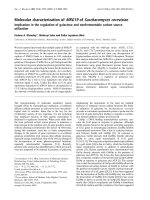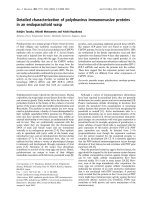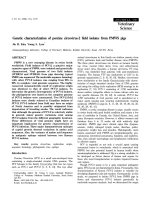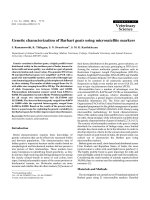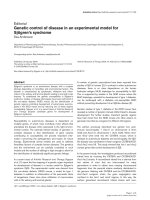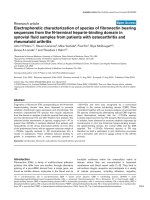Báo cáo y học: " Genetic characterization of wild-type measles viruses isolated in China, 2006-2007" doc
Bạn đang xem bản rút gọn của tài liệu. Xem và tải ngay bản đầy đủ của tài liệu tại đây (605.13 KB, 9 trang )
Ji et al. Virology Journal 2010, 7:105
/>Open Access
RESEARCH
© 2010 Ji et al; licensee BioMed Central Ltd. This is an Open Access article distributed under the terms of the Creative Commons Attri-
bution License ( which permits unrestricted use, distribution, and reproduction in any
medium, provided the original work is properly cited.
Research
Genetic characterization of wild-type measles
viruses isolated in China, 2006-2007
Yixin Ji
1
, Songtao Xu
1
, Yan Zhang
1
, Zhen Zhu
1
, Naiying Mao
1
, Xiaohong Jiang
1
, Chao Ma
2
, Peishan Lu
3
,
Changyin Wang
4
, Yong Liang
5
, Huanying Zheng
6
, Yang Liu
7
, Defang Dai
8
, Lei Zheng
9
, Jianhui Zhou
10
,
Shuang Wang
10
, Zhenying Zhang
11
, Shengwei Wu
12
, Lijuan Nan
13
, Li Li
2
, Xiaofeng Liang
2
,
David Alexander Featherstone
14
, PaulARota
15
, William J Bellini
15
and Wenbo Xu*
1
Abstract
Molecular characterization of wild-type measles viruses in China during 1995-2004 demonstrated that genotype H1
was endemic and widely distributed throughout the country. H1-associated cases and outbreaks caused a resurgence
of measles beginning in 2005. A total of 210,094 measles cases and 101 deaths were reported by National Notifiable
Diseases Reporting System (NNDRS) and Chinese Measles Laboratory Network (LabNet) from 2006 to 2007, and the
incidences of measles were 6.8/100,000 population and 7.2/100,000 population in 2006 and 2007, respectively. Five
hundred and sixty-five wild-type measles viruses were isolated from 24 of 31 provinces in mainland China during 2006
and 2007, and all of the wild type virus isolates belonged to cluster 1 of genotype H1. These results indicated that H1-
cluster 1 viruses were the predominant viruses circulating in China from 2006 to 2007. This study contributes to
previous efforts to generate critical baseline data about circulating wild-type measles viruses in China that will allow
molecular epidemiologic studies to help measure the progress made toward China's goal of measles elimination by
2012.
Introduction
Measles virus (MeV) is a single-stranded, negative-sense
RNA virus, belonging to the genus Morbillivirus, family
Paramyxoviridae, order Mononegavirales. Measles is a
vaccine-preventable disease, but is still a major killer of
infants worldwide. During 2000-2008, global measles
mortality declined by 78%, from an estimated 733,000
deaths in 2000 to 164,000 in 2008 [1,2]. Measles contin-
ues to be a leading cause of childhood morbidity and
mortality in developing countries and an outbreak threat
in the majority of countries, despite the availability of an
effective vaccine for over 40 years [3]. Molecular epide-
miologic studies can help to measure transmission path-
ways and to clarify epidemiological links during
outbreaks. MeV is considered serologically monotypic
although genetic heterogeneity has been detected among
wild type strains [1,4]. Twenty-three genotypes (A, B1-
B3, C1-C2, D1-D10, E, F, G1-G3 and H1-H2) have been
recognized by World Health Organization (WHO); how-
ever five genotypes (B1, D1, E, F, and G1) are considered
inactive since they have not been detected in the past 15
years [5,6]. Measles surveillance can also help to measure
the success of measles vaccination programs by docu-
menting the interruption of transmission of the endemic
viral genotype(s) [7,8].
The WHO Regional Committee of the Western Pacific
Region (WPR) formally declared a measles elimination
goal in 2005, and established a target date of 2012 for
regional measles elimination [9,10]. In China, a labora-
tory surveillance network for measles was established
from 2001 to provide serologic confirmation of measles
infection by IgM testing and to support measles surveil-
lance. The measles laboratory network has been estab-
lished in all 31 provinces and includes 331 prefecture-
level laboratories which perform most of the serological
testing for case confirmation. The National Measles Lab-
oratory (NML) has played an important role in measles
control and measles virus surveillance and was appointed
as a regional reference lab in WPR in 2003. To reach the
* Correspondence:
1
WHO WPRO Regional Reference Measles Lab and State Key Laboratory for
Molecular Virology & Genetic Engineering, National Institute for Viral Disease
Control and Prevention, China Center for Disease Control and Prevention,
Beijing 100050, China
Full list of author information is available at the end of the article
Ji et al. Virology Journal 2010, 7:105
/>Page 2 of 9
goal of measles elimination by 2012 in China, the Minis-
try of Health (MOH) proposed a comprehensive vaccina-
tion and surveillance programme in 2006 (Measles
Elimination Action Plan from 2006-2012 issued by
MOH). "Measles elimination action plan" keeps high rou-
tine coverage of the first dose at 8 month and the second
dose at 18-24 months and combines with supplemental
immunization activities among the age from 8 month to
14 years old.
This study describes the genetic characterization of
wild-type measles viruses reported from 24 of 31 prov-
inces in China from 2006-2007. Five hundred and sixty-
five wild-type measles viruses were isolated from throat
swab or urine specimens collected from outbreak and
sporadic cases. The results documented the continued
circulation of genotype H1 viruses throughout China.
Results
Epidemiology
In 2006 and 2007, the incidence of measles was 6.8/
100,000 and 7.2/100,000, respectively, with a total of
100,267 and 109,827 cases and 35 and 66 fatalities
reported by NNDRS. In 2004, measles incidence was >
10/100,000 in 6 of 31 provinces (Xinjiang, Xizang, Yun-
nan, Guizhou, Gansu and Zhejiang) which were located
in the developing areas of China with the exception of
Zhejiang province. However, in 2005, the incidence of
measles was > 10/100,000 in 14 of 31 provinces, which
included 8 developed (Jiangsu, Shanghai, Beijing, Tianjin,
Zhejiang, Fujian, Anhui and Guangdong) and 6 develop-
ing (Inner Mongolia, Shanxi, Gansu, Qinghai, Xizang and
Yunnan) provinces (Figure 1). Though the 14 provinces
which had measles incidence >10/100,000 population in
2005 decreased to 8 and 9 provinces in 2006 and 2007,
respectively, measles virus of the H1 genotype was still
detected in all 24 provinces sampled and was associated
with over 1500 measles outbreaks throughout China.
From 2005 to 2007, measles incidence increased signifi-
cantly in those developed provinces which previously had
low measles incidence rates (Figure 1).
In 2006 and 2007, measles cases in those < 1 and ≥15
years old also increased compared with 2004 and had
another peak at 15 to 35 years (Figure 2b). The age group
specific incidence of measles cases reported was still
highest among those under 15 years old, especially those
under one year of age. Approximately 25% of measles
cases occurred in infants 0-1 year of age from 2005 to
2007, compared with 9.0% in 2003 and less than 10% in
2004 (from NNDRS), and the peak appeared between
April and May in most years (Figure 2a).
Molecular characterization
In the study, 565 wild-type measles viruses were collected
from 24 of 31 provinces in China during the 2006-2007
measles epidemic (Table 1). The swab or urine specimens
were collected from outbreak and sporadic cases. Virus
isolation was conducted by provincial laboratories and
isolates were transported to the NLM in Beijing for
molecular characterization. In this study, with the excep-
tion of one genotype A strain from Shandong province
identified as a vaccine reaction, all strains were members
of cluster 1 of genotype H1 and no cluster 2 [11] of H1
genotype were detected in 2006-2007 (Figure 3,4, 5). The
results of the phylogenetic analysis from nucleotide posi-
tions 1230 to 1685 of the sequences of N gene are shown
in Figures 3, 4 and 5. The clustering of MeVs in China
within the genotype H1 was supported by a significant
bootstrap value (500 replicates) of 97% (Figure 3). It was
found that genotype H1 was still the predominant circu-
lating genotype in China during 2006-2007.
Genotype H1 has the greatest degree of intratypic vari-
ation among all of the genotypes, with sequences falling
into two major clusters, previously designated as cluster 1
and cluster 2 [12,15]. The sequences of genotype H1
viruses from 2006 to 2007 all were within cluster 1 (Fig-
ure 3), and two main branches within this cluster were
visible (Figure 3). The mean nucleotide difference
between these two branches of variants was 2.2%.
Compared with the WHO reference strains sequences
of all genotypes, the range of the nucleotide sequence
homologies of the 564 genotype H1 strains was 86.6%-
93.5%. With the exception of one vaccine-derived case, all
of the 564 measles viruses in 2006-2007 differed from the
vaccine strains in China, S191 and Changchun-47, by no
more than 10.1% at the nucleotide level and 16.0% at
amino acid level in the standard 450 nucleotide region of
the N gene that is used for genotyping.
Discussion
Although the average incidence of measles in China
decreased in 2006-2007 compared with 2005, however
measles incidence was >10/100,000 in 8 and 9 developed
provinces in 2006 and 2007 respectively (Figure 1), reach-
ing the goal of measles elimination by 2012 will be a chal-
lenge. Two reasons may account for the recent increase in
measles cases in China. Over 30% of measles cases from
2005 to 2007 in China were in the "floating population"
(persons without a permanent residence card for the
place in which they live) that account for up to 50% of the
population in some developed provinces and big cities
[16]. The floating population is not able to access routine
immunization services outside their official residential
area and is likely to constitute a large proportion of the
immunity gap in China. The proportion of floating peo-
ple has increased since 2005 following migration from
rural based developing provinces to the more urban
based, developed provinces. A high proportion of mea-
sles cases in young adults in cities may be responsible for
Ji et al. Virology Journal 2010, 7:105
/>Page 3 of 9
the measles incidence increase among the developed
provinces from 2005 to 2007 as this group received only a
single dose of measles vaccine as infants.
With the attainment of Universal Childhood Immuni-
zation goals [17], measles morbidity in China reached
lows in 1995. During 1995-2004, the incidence of measles
was approximately 6/100,000 population every year.
There was a resurgence of measles cases in 2005 in China
where the incidence increased to 10/100,000 population.
In 2006, the MOH issued an activity plan to achieve mea-
sles elimination by 2012. The plan recommended that the
age of the first dose of measles-containing vaccine
(MCV1) remain at 8 months, and the age of the second
dose of measles-containing vaccine (MCV2) change from
7 years to 18-24 months. China's reported two dose MCV
coverage ranged from 84.1% to 96.4% during 2003-2007,
with a mean of 92.5% [10]. The incidence dropped to 6.8/
100,000 in 2006 and 7.2/100,000 in 2007, because of the
measles supplementary immunization activities (SIAs) in
some high incidence provinces. In China, SIAs during
2003-2008 reached approximately 101 million children
and adolescents in 14 provinces [10]. The age-specific
incidence of measles cases was highest among young
children and declined with increasing age from 2006-
2007. However, the incidence rate had 2 peaks, in infants
(< 1 year old), and in adolescents and adults (>15 years
old), compared to 1995-2004. Although the developed
provinces had different incidence rates, there were no
major differences in the age distribution of cases. Fur-
thermore, the change to the measles vaccine schedule, in
which the second dose administered to children was
changed from 7 year old to 18-24 months in 2005, could
have accounted for changing the age distribution.
The virologic surveillance for measles virus that began
in China in 1993 is one of the most thorough programs in
the global network. Through this time only a single geno-
type, H1, has been detected in China. Measles surveil-
lance in other countries in Asia has confirmed that
endemic circulation of genotype H1 is limited to only
China [18]. Analyses conducted during the early part of
Figure 1 Measles Incidence in China 2004-2007. The maps show incidence of measles by province for the years 2004, 2005, 2006 and 2007. Color
code at bottom of each map indicates the incidence rate. In 2004, Xinjiang, Xizang, Yunnan, Guizhou, Gansu and Zhejiang: measles incidence was
>10/100,000. In 2005, Jiangsu, Shanghai, Beijing, Tianjin, Zhejiang, Fujian, Anhui, Guangdong, Inner Mongolia, Shanxi, Gansu, Qinghai, Xizang and Yun-
nan: the incidence of measles was >10/100,000
2007
2004
2006
2005
Ji et al. Virology Journal 2010, 7:105
/>Page 4 of 9
the last decade identified two lineages within the Chinese
H1 viruses and these were designated cluster 1 and clus-
ter 2 with cluster 1 viruses being the most frequently
detected strains. The genetic analysis of wild-type mea-
sles isolated in 2006 and 2007 indicated that cluster 1 is
still the most frequently detected lineage in China. There
were no cluster 2 viruses isolated during 2006-2007, com-
pared with 26.9% of all strains detected in 1993-2000 and
5.4% in 2001-2005 [12,13,15,16]. This finding suggested
that measles vaccination programme was able to reduce
the genetic diversity of circulating measles virus from
1993 to 2007 in China. Even though the genotype H1
Figure 2 Age-specific and Month-specific of cases of measles in China, 2004-2007. Figure 2a shows month-specific of measles cases from 2004-
2007 with different color bar. Figure 2b shows age-specific of measles from 0-70 years old and 0-10 years old.
0
10000
20000
30000
40000
50000
60000
0- 5- 10- 15- 20- 25- 30- 35- 40- 45- 50- 55- 60- 65- 70-
Measles cases
Age group
0
5000
10000
15000
20000
25000
30000
0- 1- 2- 3- 4- 5- 6- 7- 8- 9-
Measles cases
Age group
2004
2005
2006
2007
Measles cases
Month
2a
2b
Table 1: The list of measles virus isolates in 2006-2007.
Province Number Genotype Province Number Genotype
06 07 H1 06 07 H1
Hunan 18 11 cluster1 Jilin 10 cluster1
Henan 1 65 cluster1 Hebei 30 8 cluster1
Shandong 21 61 cluster1, A* Guangdong 39 18 cluster1
Sichuan 2 12 cluster1 Neimenggu 7 10 cluster1
Jiangsu 45 14 cluster1 Shanghai 24 cluster1
Ningxia 2 19 cluster1 Shanxi 27 5 cluster1
Jiangxi 1 5 cluster1 Yunnan 14 1 cluster1
Shaanxi 2 cluster1 Tianjin 16 cluster1
Guangxi 1 14 cluster1 Liaoning 11 6 cluster1
Heilongjiang 7 1 cluster1 Anhui 3 cluster1
Guizhou 12 cluster1 Chongqing 5 6 cluster1
Gansu 7 1 cluster1 Fujian 3 cluster1
Total 565
*Note, one measles virus of genotype A from Shandong provinces was isolated from a vaccine-derived case.
Ji et al. Virology Journal 2010, 7:105
/>Page 5 of 9
Figure 3 Phylogenetic tree of measles wild-type virus strains of China in 2006-2007 and WHO reference MeV strains (black dots) based on
the 456 nucleotide sequences coding for the COOH-terminus of the nucleoprotein. The dendrogram was created with MEGA4 software and
the neighbor-joining method (500 bootstraps). Genetic distances are represented as numbers of nucleotide differences between strains.
Mvi/Anhui.PRC/05.07/1
Mvi/Anhui.PRC/07.07/1
Mvi/Neim eng.PRC/05.07/1
Mvi/Shandong.PRC/24.07/12
Mvi/Guangdong.PRC/17.06/1
Mvi/Guangdong.PRC/25.06/1
Mvi/Guangdong.PRC/22.06/1
Mvi/Guangdong.PRC/33.06/1
Mvi/Neim eng.PRC/22.07/1
Mvi/Guangdong.PRC/20.06/4
Mvi/Hunan.PRC/15.07/1
Mvi/Neim eng.PRC/05.07/2
Mvi/Neim eng.PRC/24.07/1
Mvi/Shandong.PRC/21.07/2
Mvi/Liaoning.PRC/24.07/1
Mvi/Yunnan.PRC/45.06/1
Mvi/Guangdong.PRC/26.06/2
Mvi/Guangdong.PRC/24.07/1
Mvi/Hebei.PRC/11.07/1
Mvi/Heilongjiang.PRC/17.07/1
Mvi/Shandong.PRC/13.07/1
Mvi/Shanxi.PRC/03.07/1
Mvi/Gansu.PRC/12.07/1
Mvi/Ningxia.PRC/14.04/1
Mvi/Chongqing.PRC/16.07/1
Mvi/Yunnan.PRC/46.07/1
Mvi/Guangxi.PRC/51.07/1
Mvi/Hunan.PRC/21.07/1
Mvi/Hunan.PRC/12.07/1
Mvi/Shanghai.PRC/15.07/1
Mvi/Guizhou.PRC/10.07/1
Mvi/Hebe i.PRC/13.06/2
Mvi/Hebe i.PRC/25.06/1
Mvi/sichuan.PRC/46.07/1
Mvi/Tianjin.PRC/20.06/1
Mvi/Tianjin.PRC/06.06/1
Mvi/Jiangsu.PRC/09.06/1
Mvi/Chongqing.PRC/15.07/1
Mvi/Shandong.PRC/14.06/2
Mvi/Guangdong.PRC/04.07/1
Mvi/Tianjin.PRC/10.06/1
Mvi/sichuan.PRC/13.07/1
Mvi/Hebei.PRC/08.06/1
Mvi/Ningxia.PRC/06.06/1
Mvi/Hunan.PRC/08.06/1
Mvi/Yunnan.PRC/52.06/1
Mvi/Jiangsu.PRC/07/9
Mvi/Gansu.PRC/09.06/1
Mvi/Sichuan.PRC/12.06/1
Mvi/Heilongjiang.PRC/16.06/1
Mvi/Jiangsu.PRC/07/1
Mvi/Jiangsu.PRC/07/3
Mvi/Jiangsu.PRC/07/7
Mvi/Shanxi.PRC/06.06/3
Mvi/Shanxi.PRC/17.07/1
Mvi/Hunan.PRC/12.06/5
Mvi/Yunnan.PRC/48.06/1
Mvi/Shanxi.PRC/03.06/1
Mvi/Guizhou.PRC/02.07/1
Mvi/Liaoning.PRC/10.06/1
Mvi/Liaoning.PRC/12.06/1
Mvi/Shanxi.PRC/23.06/1
Mvi/Hunan.PRC/15.06/1
Mvi/Henan.PRC/03.07/1
Mvi/Jilin.PRC/13.06/1
Mvi/Henan.PRC/01.07/1
Mvi/Hebe i.PRC/15.07/1
Mvi/Liaoning.PRC/21.07/1
Mvi/Chongqing.PRC/06.06/1
Mvi/Henan.PRC/14.07/1
Mvi/Ningxia.PRC/19.04/1
Mvi/Heilongjiang.PRC/13.06/1
Mvi/Liaoning.PRC/15.06/1
Mvi/Shandong.PRC/10.06/1
Mvi/Tianjin.PRC/15.06/1
Mvi/Ningxia.PRC/17.04/1
Mvi/Shanghai.PRC/01.07/1
Mvi/Fujian.PRC/22.07/1
Mvi/Fujian.PRC/25.07/1
Mvi/Shanghai.PRC/21.07/1
Mvi/Shanxi.PRC/09.06/1
Mvi/Guangxi.PRC/50.07/1
Mvi/Hebe i.PRC/24.07/1
Mvi/Jiangsu.PRC/12.06/1
Mvi/Jiangsu.PRC/10.06/1
Mvi/Ningxia.PRC/09.06/1
Cluster1
Hunan.CHN/93/7(H1)
MVi/Henan.PRC/21.99/5
MVi/Hainan.PRC/16.03/3
MVi/Chongqing.PRC/12.00/2
MVi/Hunan.PRC/15.95/9
MVi/Henan.PRC/20.02/1
MVi/Shanghai.PRC/15.01/1
MVi/Hunan.PRC/18.95/18
MVi/Henan.PRC/25.03/1
Mvi/Taichung.TWN/36.02
MVi/Guizhou.PRC/23.04/1
MVi/Xinjiang.PRC/12.04/1
MVi/Hebe i.PRC/13.05/2
MVi/Shandong.PRC/21.05/2
Cluster2
Mvi/Shandong.PRC/14.07/1
0.01
Variant
2
Variant
1
99
97
Ji et al. Virology Journal 2010, 7:105
/>Page 6 of 9
Figure 4 Phylogenetic tree of measles wild-type virus strains of China in 2006 and H1 reference MeV strains based on the 450 nucleotide
sequences coding for the COOH-terminus of the nucleoprotein. The black triangles indicate MeV isolates Taiwan or Hong Kong China.
Mvi/G uangdong.PRC/07.06/4
Mvi/Liaoning.PRC/12.06/4
Mvi/G uangdong.PRC/20.06/8
Mvi/Guangdong.PRC/20.06/5
Mvi/G uangdong.PRC/20.06/6
Mvi/Liaoning.PRC/12.06/3
Mvi/Hunan.PRC/12.06/4
Mvi/Shandong.PRC/10.06/11
Mvi/Shandong.PRC/16.06/1
Mvi/G uangdong.PRC/23.06/4
Mvi/G uangdong.PRC/26.06/2
Mvi/Guangdong.PRC/24.06/1
Mvi/Guangdong.PRC/18.06/1
Mvi/Guangdong.PRC/19.06/3
Mvi/G uangdong.PRC/21.06/2
Mvi/Jiangsu.PRC/10.06/2
Mvi/Jiangsu.PRC/10.06/3
Mvi/Jiangsu.PRC/07.06/1
Mvi/Jiangsu.PRC/09.06/1
Mvi/Jiangsu.PRC/06.06/1
Mvi/Jiangsu.PRC/09.06/3
Mvi/Jiangsu.PRC/06.06/7
Mvi/G uangdong.PRC/19.06/1
Mvi/Hebei.PRC/25.06/1
Mvi/Hunan.PRC/15.06/4
Mvi/Tianjin.PRC/06.06/1
MV s/Taipei.TW N/39.06
Mvi/Tianjin.PRC/20.06/1
Mvi/Hebei.PRC/13.06/2
Mvi/Tianjin.PRC/12.06/1
Mvi/Hunan.PRC/13.06/2
MV s/HongKong.PRC/31.06/50
Mvi/Hunan.PRC/15.06/2
Mvi/Y unnan.PRC/45.2006/1
Mvi/Y unnan.PRC/45.2006/2
Mvi/Y unnan.PRC/52.06/1
Mvi/Hunan.PRC/12.06/3
Mvi/Hunan.PRC/08.06/1
Mvi/Hunan.PRC/13.06/1
Mvi/Tianjin.PRC/09.06/2
Mvi/Hebei.PRC/08.06/1
Mvi/Ningxia.PRC/06.06/1
Mvi/Hebei.PRC/19.06/2
Mvi/Heilongjiang.PRC/16.06/2
Mvi/Hebei.PRC/11.06/4
Mvi/Shandong.PRC/14.06/2
Mvi/Jiangsu.PRC/13.06/2
Mvi/Sichuan.PRC/12.06/1
Mvi/Gansu.PRC/09.06/1
M v i/Tia n jin .P R C /1 0 .06 /1
Mvi/Tianjin.PRC/11.06/1
Mvi/Jiangsu.PRC/14.06/2
Mvi/Jiangsu.PRC/06.06/6
Mvi/Jiangsu.PRC/14.06/3
Mvi/Hebei.PRC/23.06/2
Mvi/Heilongjiang.PRC/16.06/1
Mvi/Heilongjiang.PRC/04.06/2
Mvi/G uangdong.PRC/28.06/1
Mvi/Guangdong.PRC/22.06/1
Mvi/Guangdong.PRC/22.06/2
Mvi/G uangdong.PRC/22.06/3
Mvi/G uangdong.PRC/23.06/1
Mvi/Guangdong.PRC/26.06/3
Mvi/G uangdong.PRC/33.06/1
Mvi/Guangdong.PRC/25.06/1
Mvi/G uangdong.PRC/20.06/1
Mvi/G uangdong.PRC/17.06/1
Mvi/G uangdong.PRC/23.06/3
Mvi/G uangdong.PRC/19.06/2
Mvi/G uangdong.PRC/20.06/3
Mvi/G uangdong.PRC/20.06/4
Mvi/G uangdong.PRC/07.06/1
Mvi/G uangdong.PRC/07.06/3
Mvi/Guangdong.PRC/07.06/2
Mvi/Guangdong.PRC/19.06/4
Mvi/G uangdong.PRC/20.06/7
Mvi/G uangdong.PRC/19.06/5
Mvi/Guangdong.PRC/34.06/1
Mvi/Liaoning.PRC/10.06/1
Mvi/Liaoning.PRC/12.06/2
Mvi/Liaoning.PRC/12.06/1
Mvi/Shanxi.PRC/23.06/1
Mvi/Liaoning.PRC/11.06/2
Mvi/Hebei.PRC/23.06/3
Mvi/Heilongjiang.PRC/11.06/1
Mvi/Jiangsu.PRC/13.06/1
Mvi/Liaoning.PRC/11.06/1
Mvi/Shandong.PRC/14.06/4
M v i/ T ia n jin . P R C /1 1 .0 6 /2
Mvi/Y unnan.PRC/45.2006/3
Mvi/Hunan.PRC/15.06/1
MV s/HongKong.PRC/23.06/33
Mvi/Chongqing.PRC/06.06/1
Mvi/Gansu.PRC/09.06/2
Mvi/G ansu.PRC/14.06/1
Mvi/Jiangsu.PRC/09.06/2
Mvi/Shandong.PRC/14.06/6
Mvi/Shanxi.PRC/21.06/1
M v i/ T ia n jin . P R C /1 9 .0 6 /2
Mvi/Tianjin.PRC/19.06/3
Mvi/Heilongjiang.PRC/16.06/3
Mvi/Hebei.PRC/11.06/1
Mvi/Hebei.PRC/23.06/1
Mvi/Hunan.PRC/12.06/1
M v i/ T ia n jin . P R C /0 9 .0 6 /1
Mvi/Y unnan.PRC/48.06/1
Mvi/Y unnan.PRC/52.06/3
Mvi/Y unnan.PRC/52.06/4
Mvi/Y unnan.PRC/51.06/2
Mvi/Shandong.PRC/10.06/8
Mvi/Jiangsu.PRC/15.06/1
Mvi/Chongqing.PRC/05.06/1
Mvi/Jiangsu.PRC/13.06/4
Mvi/Jiangsu.PRC/10.06/6
Mvi/Shanxi.PRC/08.06/4
Mvi/Shanxi.PRC/03.06/1
Mvi/Shanxi.PRC/04.06/1
Mvi/Shandong.PRC/10.06/5
Mvi/Hunan.PRC/12.06/5
Mvi/Shanxi.PRC/06.06/3
Mvi/Hebei.PRC/17.06/3
Mvi/Jiangsu.PRC/10.06/4
Mvi/Jiangsu.PRC/08.06/2
Mvi/Hunan.PRC/12.06/2
Mvi/Shanxi.PRC/08.06/3
Mvi/Shanxi.PRC/08.06/1
Mvi/Shanxi.PRC/10.06/8
Mvi/Shanxi.PRC/10.06/1
Mvi/Shanxi.PRC/10.06/9
Mvi/Liaoning.PRC/15.06/2
Mvi/Shandong.PRC/10.06/6
Mvi/Shanxi.PRC/08.06/2
Mvi/Shandong.PRC/10.06/3
Mvi/Shandong.PRC/14.06/3
MV s/HongKong.PRC/13.06/7
Mvi/Tianjin.PRC/12.06/2
Mvi/Hunan.PRC/15.06/3
Mvi/Heilongjiang.PRC/13.06/1
Mvi/Hunan.PRC/13.06/3
Mvi/Jiangsu.PRC/10.06/1
Mvi/Ningxia.PRC/09.06/1
Mvi/Jiangsu.PRC/12.06/1
Mvi/Jiangsu.PRC/08.06/1
Mvi/Jiangsu.PRC/13.06/5
Mvi/Jiangsu.PRC/14.06/4
Mvi/Tianjin.PRC/15.06/1
Mvi/Shandong.PRC/10.06/1
Mvi/Shandong.PRC/16.06/3
Mvi/Tianjin.PRC/19.06/1
Mvi/Shanxi.PRC/10.06/5
Mvi/Guangdong.PRC/20.06/2
Mvi/Heilongjiang.PRC/04.06/1
Mvi/Jiangsu.PRC/06.06/4
Mvi/Hebei.PRC/17.06/1
Mvi/Liaoning.PRC/15.06/1
Mvi/Hebei.PRC/14.06/1
Mvi/Shanxi.PRC/09.06/1
Mvi/Shanxi.PRC/10.06/7
Cluster 1
MV i/Henan.PRC/21.99/5
MV i/Hainan.PRC/16.03/3
MV i/Chongqing.PRC/12.00/2
MV i/Henan.PRC/20.02/1
MV i/Hunan.PRC/15.95/9
MV i/Shanghai.PRC/15.01/1
MV i/Hunan.PRC/18.95/18
MV i/Henan.PRC/25.03/1
Mvi/Taichung.TW N/36.02
MV i/G uizhou.PRC/23.04/1
MV i/Xinjiang.PRC/12.04/1
MV i/Hebei.PRC/13.05/2
MV i/Shandong.PRC/21.05/2
Cluster 2
S-191
Changchun-47
0.01
Ji et al. Virology Journal 2010, 7:105
/>Page 7 of 9
Figure 5 Phylogenetic tree of measles wild-type virus strains of China in 2007 and H1 reference MeV strains based on the 450 nucleotide
sequences coding for the COOH-terminus of the nucleoprotein. The MeV isolates from Taiwan and Hong Kong China were identified by a BLAST
search from of GenBank (shown by black triangles).
Mvi/Shandong.PRC/24.07/12
Mvi/Shandong.PRC/24.07/9
Mvi/Shandong.PRC/24.07/8
Mvi/Shandong.PRC/26.07/3
Mvi/Neimeng.PRC/05.07/1
Mvi/Shandong.PRC/24.07/11
Mvi/Shandong.PRC/24.07/13
Mvi/Shandong.PRC/14.07/3
Mvi/Shandong.PRC/24.07/1
Mvi/A nhui.PRC/07.07/2
Mvi/A nhui.PRC/05.07/1
Mvi/A nhui.PRC/07.07/1
Mvi/Neimeng.PRC/22.07/1
Mvi/Hunan.PRC/15.07/1
Mvi/Hunan.PRC/09.07/3
Mvi/Neimeng.PRC/24.07/1
Mvi/Hunan.PRC/11.07/1
Mvi/Neimeng.PRC/05.07/2
Mvi/Shandong.PRC/21.07/1
Mvi/Shandong.PRC/23.07/3
Mvi/Shandong.PRC/13.07/9
Mvi/Shandong.PRC/21.07/2
Mvi/Liaoning.PRC/24.07/1
Mvi/sichuan.PRC/15.07/1
Mvi/Hunan.PRC/09.07/2
Mvi/Shanghai.PRC/12.07/2
Mvi/Henan.PRC/02.07/7
Mvi/Hebei.PRC/11.07/1
Mvi/Shanghai.PRC/04.07/1
Mvi/Ningxia.PRC/14.07/1
Mvi/Shanghai.PRC/02.07/1
Mvi/Heilongjiang.PRC/17.07/1
Mvi/Hunan.PRC/10.07/1
Mvi/Shandong.PRC/12.07/1
Mvi/Shandong.PRC/13.07/8
Mvi/Shanxi.PRC/03.07/1
Mvi/Jiangxi.PRC/04.07/1
Mvi/Henan.PRC/02.07/14
Mvi/Liaoning.PRC/21.07/3
Mvi/Gansu.PRC/12.07/1
Mvi/Shandong.PRC/13.07/1
Mvi/Chongqing.PRC/15.07/2
Mvi/Hunan.PRC/09.07/1
Mvi/Ningxia.PRC/08.07/1
Mvi/Guangdong.PRC/24.07/1
Mvi/Ningxia.PRC/20.07/1
Mvi/Shandong.PRC/15.07/1
Mvi/Shanghai.PRC/01.07/2
MV s/HongKong.CHN/36.07/1
Mvi/sichuan.PRC/46.07/1
Mvi/sichuan.PRC/15.07/3
Mvi/sic huan.PRC/46.07/2
Mvi/Tainan.TW N/33.07
Mvi/Hebei.PRC/17.07/1
Mvi/Shanghai.PRC/13.07/1
Mvi/Hunan.PRC/21.07/1
Mvi/Chongqing.PRC/16.07/1
MV i/Taipei.TW N/30.07
MV s/HongKong.CHN/13.07
Mvi/Guangxi.PRC/51.07/1
Mvi/Shanghai.PRC/20.07/3
Mvi/Guangdong.PRC/34.07/1
Mvi/Y unnan.PRC/46.07/1
Mvi/Henan.PRC/03.07/7
MV s/HongKong.CHN/21.07/4
Mvi/Henan.PRC/02.07/2
Mvi/Liaoning.PRC/21.07/2
Mvi/Chongqing.PRC/15.07/1
Mvi/Shanghai.PRC/18.07/1
Mvi/Hunan.PRC/12.07/2
MV s/HongKong.CHN/26.07/2
Mvi/Guizhou.PRC/10.07/1
Mvi/Henan.PRC/02.07/6
Mvi/Hunan.PRC/12.07/1
Mvi/Shanghai.PRC/15.07/1
MV s/HongKong.CHN/44.07
Mvi/Henan.PRC/02.07/20
Mvi/Guangdong.PRC/13.07/1
Mvi/Guizhou.PRC/09.07/1
Mvi/Henan.PRC/01.07/4
MV s/HongKong.CHN/29.07
Mvi/Henan.PRC/03.07/3
Mvi/Guangdong.PRC/04.07/1
Mvi/Henan.PRC/02.07/19
M v i/J ia n g s u .P R C /0 7 /9
Mvi/Shanghai.PRC/04.07/2
Mvi/Guangdong.PRC/04.07/7
Mvi/sichuan.PRC/15.07/2
Mvi/sichuan.PRC/13.07/1
Mvi/Shanghai.PRC/20.07/2
Mvi/Shanghai.PRC/10.07/2
Mvi/Jiangsu.PRC/07/6
Mvi/Jiangsu.PRC/07/3
Mvi/Jiangsu.PRC/07/7
Mvi/Jiangsu.PRC/07/5
Mvi/Jiangsu.PRC/07/8
Mvi/Ningxia.PRC/17.07/2
Mvi/Ningxia.PRC/17.07/3
Mvi/Shanghai.PRC/12.07/1
Mvi/Shanxi.PRC/17.07/1
Mvi/Neimeng.PRC/12.07/1
Mvi/Henan.PRC/02.07/22
M v i/ G u iz h o u . P R C / 0 2 .0 7 / 1
Mvi/Shannxi.PRC/20.07/1
Mvi/sichuan.PRC/14.07/1
MV s/HongKong.CHN/48.07
Mvi/Shanxi.PRC/05.07/1
Mvi/Liaoning.PRC/21.07/1
Mvi/Hebei.PRC/15.07/1
Mvi/Shanghai.PRC/20.07/1
Mvi/Henan.PRC/01.07/1
Mvi/Henan.PRC/02.07/10
Mvi/Henan.PRC/03.07/1
Mvi/Henan.PRC/03.07/2
Mvi/Ningxia.PRC/10.07/1
Mvi/Henan.PRC/03.07/6
Mvi/Henan.PRC/10.07/3
Mvi/Ningxia.PRC/19.07/2
Mvi/Shandong.PRC/24.07/2
Mvi/Shandong.PRC/26.07/2
Mvi/Shandong.PRC/24.07/3
Mvi/Shandong.PRC/23.07/1
Mvi/Shandong.PRC/24.07/4
Mvi/Shandong.PRC/26.07/1
Mvi/Shandong.PRC/24.07/5
Mvi/Hunan.PRC/15.07/2
Mvi/Jiangsu.PRC/07/11
Mvi/Hunan.PRC/09.07/4
Mvi/Jiangsu.PRC/07/10
Mvi/Shandong.PRC/24.07/7
Mvi/Shandong.PRC/14.07/2
Mvi/Shandong.PRC/23.07/5
Mvi/Jiangsu.PRC/07/12
Mvi/Jiangsu.PRC/07/4
Mvi/Jiangsu.PRC/07/1
Mvi/Jiangsu.PRC/07/2
Mvi/Henan.PRC/01.07/3
Mvi/Henan.PRC/14.07/1
Mvi/Ningxia.PRC/19.07/1
Mvi/Shanghai.PRC/10.07/1
MV s/HongKong.CHN/06.07
Mvi/Guizhou.PRC/08.07/1
MV s/HongKong.CHN/49.07/2
Mvi/Henan.PRC/04.07/5
Mvi/Hebei.PRC/16.07/1
Mvi/Henan.PRC/02.07/17
Mvi/Ningxia.PRC/17.07/1
Mvi/Fujian.PRC/22.07/1
Mvi/Henan.PRC/10.07/4
Mvi/Shanghai.PRC/01.07/1
Mvi/Hebei.PRC/24.07/1
0Mvi/Shandong.PRC/13.07/3
Mvi/Neimeng.PRC/19.07/1
Mvi/Guangxi.PRC/50.07/1
Mvi/Ningxia.PRC/12.07/1
Mvi/Shandong.PRC/13.07/7
Mvi/Fujian.PRC/25.07/1
Mvi/Shanghai.PRC/21.07/1
Cluster1
MV i/Henan.PRC/21.99/5
MV i/Hainan.PRC/16.03/3
MV i/Chongqing.PRC/12.00/2
MV i/Henan.PRC/20.02/1
MV i/Hunan.PRC/15.95/9
MV i/Shanghai.PRC/15.01/1
MV i/Hunan.PRC/18.95/18
MV i/Henan.PRC/25.03/1
Mvi/Taichung.TW N/36.02
MV i/G uizhou.PRC/23.04/1
MV i/Xinjiang.PRC/12.04/1
MV i/Hebei.PRC/13.05/2
MV i/Shandong.PRC/21.05/2
Cluster2
Changchun-47
S-191
Mvi/Shandong.PRC/14.07/1
0.01
Ji et al. Virology Journal 2010, 7:105
/>Page 8 of 9
viruses in China are genetically diverse, no geographic
restriction of particular lineages is evident. The major
neutralization sites and N-glycosylation sites in the
hemagglutinin were not changed in the more recent gen-
otype H1 viruses compared to those isolates. Compared
China vaccine strain, the 719th nucleotide of H1 wild
strains in China was changed from G to A in amino acid
mutation from Ser to Asn. Furthermore, one N-glycosyla-
tion site in 240th amino acids was loosen because of the
mutation [14]. Therefore, the amino acid mutation in the
H protein of the Chinese viruses did not appear to the
result in loss of mayor neutralization epitopes by cross
antibody induced following vaccination.
MeVs with identical sequences were associated with
outbreaks in multiple provinces, and these lineages were
detected in multiple provinces for several years. The
sequences from the recent genotype H1 viruses that were
imported into Europe, Taiwan and Hong Kong showed
100% sequence identity with genotype H1 viruses that
were circulating in mainland China or were associated
with international importation of virus [19]. Molecular
epidemiologic studies of measles virus are an important
component of measles surveillance in China because they
will help to document interruption of transmission of the
endemic genotype, H1, a key criterion for verification of
measles elimination. Measles surveillance is also neces-
sary to monitor the stability of the neutralization epitopes
on the viral hemagglutinin.
Conclusion
This study reports measles surveillance from 24 prov-
inces of China during 2006 to 2007. The results con-
firmed that genotype H1-cluster 1 is the endemic
genotype circulating in China from 2006 to 2007. Genetic
analyses of viral samples from the Chinese laboratory
network were consistent with endemic measles, in that
multiple chains of transmission were evident. However a
reduction in genetic diversity suggests that recently intro-
duced enhanced measles control strategies are having an
impact in China.
Materials and methods
Epidemiologic data
Numbers and descriptive information of measles cases
and deaths in this report were obtained from the National
Notifiable Diseases Reporting System of China CDC
(NNDRS). Population denominators for calculation of
incidence and mortality rates were determined on the
basis of data reported by the National Bureau of Statis-
tics. Epidemiologic data were analyzed by using Micro-
soft Excel and Epi Map.
Specimen collection and Virus isolation
Urine, throat swab and blood samples were collected
from patients who had acute, febrile maculopapular rash
from 24 provinces in China. All clinical samples were col-
lected within five days of rash onset and transported in
accordance with standard protocols [20,21]. Isolation of
MeV was performed using the Vero/hSLAM cell line and
the cells were harvested when the cytopathic effect (CPE)
was visible over at least 50-75% of the cell layer [6,22].
RNA Extraction and RT-PCR
RNA was extracted from 250 μl of infected cell lysate
using a Trizol reagent, following the manufacturer's
instructions. For all virus isolates, RT-PCR amplification
was performed using previously described primers to
amplify a 600bp fragment in the N gene which included
the 450bp fragment recommended for genotyping [13].
PCR products were purified using the QIAquick Gel
Extraction kit (QIAGEN).
Sequence analysis
Sequences of the PCR products were derived by auto-
mated sequencing and the BigDye terminator v3.0 chem-
istry according to the manufacturer's protocol in both
sense and antisense strands by an automated ABI
PRISM™ 3100 DNA Sequencer (Perkin Elmer). Sequence
proof reading and editing was conducted with
Sequencer™ (Gene Codes Corporation). Sequence data
were analyzed using version 7.0 of Bioedit and phyloge-
netic analyses were performed using Bioedit and Mega4
[23]. The robustness of the groupings was assessed using
bootstrap resampling of 500 replicates and the trees were
visualized with Mega programs. Nucleotide sequence
data from 313 representative strains were deposited in
GenBank under accession numbers: GU237175
-
GU237481
List of Abbreviations
NNDRS: National Notifiable Diseases Reporting System;
MeV: Measles virus; RT-PCR: reverse transcriptase poly-
merase chain reaction; CPE: cytopathic effect; N: Nucleo-
protein; WHO: World Health Organization; WPR:
Western Pacific Region;
Competing interests
The authors declare that they have no competing interests.
Authors' contributions
YXJ carried out most of the studies and drafted the manuscript. WBX designed
the study and organized the coordination. YXJ, STX, YZ, ZZ and NYM per-
formed parts of the studies and sequence analysis. XHJ, JHZ, PSL, CYW, YL, HYZ,
collected specimens and performed virus isolation, viral identification. PAR and
DAF provided consultation and editing of the manuscript. All authors read and
approved the final manuscript.
Ji et al. Virology Journal 2010, 7:105
/>Page 9 of 9
Acknowledgements
The authors thank all the provincial and prefecture measles laboratory staffs
and epidemiologists in mainland of China for providing clinical specimens, iso-
lates and epidemiologic data. We thank WHO HQ, WPRO, US CDC and Japan
International Cooperation Agency (JICA).
This study was supported by Grants: The Key Technologies R&D Program of
National Ministry of Science and Technology: 2008ZX10004-008,
2008ZX10004-014-5, 2009ZX10004-201, 2009ZX10004-202, and WHO EPI proj-
ect. The key technologies R&D program funding play a role in the interpreta-
tion of data, in the writing of the manuscript and in the decision to submit the
manuscript for publication. WHO EPI project fills the role of study design, data
collection and analysis.
Author Details
1
WHO WPRO Regional Reference Measles Lab and State Key Laboratory for
Molecular Virology & Genetic Engineering, National Institute for Viral Disease
Control and Prevention, China Center for Disease Control and Prevention,
Beijing 100050, China,
2
National Immunization Program, China Center for
Disease Control and Prevention, China,
3
Jiangsu Provincial Center for Disease
Control and Prevention, China,
4
Shandong Provincial Center for Disease
Control and Prevention, China,
5
Hebei Provincial Center for Disease Control
and Prevention, China,
6
Guangdong Provincial Center for Disease Control and
Prevention, China,
7
Tianjin Provincial Center for Disease Control and
Prevention, China,
8
Hunan Provincial Center for Disease Control and
Prevention, China,
9
Shanxi Provincial Center for Disease Control and
Prevention, China,
10
Jilin Provincial Center for Disease Control and Prevention,
China,
11
Henan Provincial Center for Disease Control and Prevention, China,
12
Guizhou Provincial Center for Disease Control and Prevention, China,
13
Neimeng Provincial Center for Disease Control and Prevention, China,
14
Immunization, Vaccines and Biologicals, World Health Organization, Geneva,
Switzerland and
15
Division of Viral Diseases, Centers for Disease Control and
Prevention, 1600 Clifton Road, Atlanta, GA 30333, USA
References
1. Knipe DMH, Peter M: Fields Virology. Measles Virus 5th edition. 2007,
2:1551-1586.
2. Global measles mortality, 2000-2008. MMWR Morb Mortal Wkly Rep
2009, 58:1321-1326.
3. WHO: Global Measles and Rubella Laboratory Network, January 2004-
June 2005. MMWR Morb Mortal Wkly Rep 2005, 54:1100-1104.
4. Bellini WJ, Rota PA: Genetic diversity of wild-type measles viruses:
implications for global measles elimination programs. Emerg Infect Dis
1998, 4:29-35.
5. Rota PA, Bellini WJ: Update on the global distribution of genotypes of
wild type measles viruses. J Infect Dis 2003, 187(Suppl 1):S270-276.
6. WHO: New genotype of measles virus and update on global
distribution of measles genotypes. Wkly Epidemiol Rec 2005, 80:347-351.
7. Rota JS, Heath JL, Rota PA, King GE, Celma ML, Carabana J, Fernandez-
Munoz R, Brown D, Jin L, Bellini WJ: Molecular epidemiology of measles
virus: identification of pathways of transmission and implications for
measles elimination. J Infect Dis 1996, 173:32-37.
8. Rota PA, Rota JS, Redd SB, Papania MJ, Bellini WJ: Genetic analysis of
measles viruses isolated in the united states between 1989 and 2001:
absence of an endemic genotype since 1994. J Infect Dis 2004,
189(Suppl 1):S160-164.
9. WHO: Press releasesWHO Regional EPI targets: eliminate measles and
control hepatitis B by 2012. Fifty-sixth session of the WHO Regional
Committee for the Western Pacific 2005.
10. Progress toward the 2012 measles elimination goal Western Pacific
Region, 1990-2008. MMWR Morb Mortal Wkly Rep 2009, 58:669-673.
11. Zhang Y, Zhou J, Bellini WJ, Xu W, Rota PA: Genetic characterization of
Chinese measles vaccines by analysis of complete genomic sequences.
J Med Virol 2009, 81:1477-1483.
12. Zhang Y, Ji Y, Jiang X, Xu S, Zhu Z, Zheng L, He J, Ling H, Wang Y, Liu Y, Du
W, Yang X, Mao N, Xu W: Genetic characterization of measles viruses in
China, 2004. Virol J 2008, 5:120.
13. Zhang Y, Zhu Z, Rota PA, Jiang X, Hu J, Wang J, Tang W, Zhang Z, Li C,
Wang C, Wang T, Zheng L, Tian H, Ling H, Zhao C, Ma Y, Lin C, He J, Tian J,
Ma Y, Li P, Guan R, He W, Zhou J, Liu G, Zhang H, Yan X, Yang X, Zhang J, Lu
Y, et al.: Molecular epidemiology of measles viruses in China, 1995-
2003. Virol J 2007, 4:14.
14. Liffick SL, Thi Thoung N, Xu W, Li Y, Phoung Lien H, Bellini WJ, Rota PA:
Genetic characterization of contemporary wild-type measles viruses
from Vietnam and the People's Republic of China: identification of two
genotypes within clade H. Virus Res 2001, 77:81-87.
15. Xu W, Tamin A, Rota JS, Zhang L, Bellini WJ, Rota PA: New genetic group
of measles virus isolated in the People's Republic of China. Virus Res
1998, 54:147-156.
16. Ji Y, Zhang Y, Xu S, Zhu Z, Zuo S, Jiang X, Lu P, Wang C, Liang Y, Zheng H,
Liu Y, Mao N, Liang X, Featherstone DA, Rota PA, Bellini WJ, Xu W: Measles
resurgence associated with continued circulation of genotype H1
viruses in China, 2005. Virol J 2009, 6:135.
17. Plan of action for implementing theWorld Declaration on the Survival,
Protection and Development of Children in the 1990s. New York:
United Nations Children's Fund; 1990.
18. Rota PA, Featherstone DA, Bellini WJ: Molecular epidemiology of measles
virus. Curr Top Microbiol Immunol 2009, 330:129-150.
19. Cheng WY, Lee L, Rota PA, Yang DC: Molecular evolution of measles
viruses circulated in Taiwan 1992-2008. Virol J 2009, 6:219.
20. Organization WH: Measles Lab Manual from the World Health
Organization. 2nd edition. 2007.
21. CDC US: Standard Protocols for Molecular Epidemiology Measles Virus
Section, CDC. .
22. Ono N, Tatsuo H, Hidaka Y, Aoki T, Minagawa H, Yanagi Y: Measles viruses
on throat swabs from measles patients use signaling lymphocytic
activation molecule (CDw150) but not CD46 as a cellular receptor. J
Virol 2001, 75:4399-4401.
23. Kumar STKNM: MEGA3: Integrated Software for Molecular Evolutionary
Genetics Analysis and Sequence Alignment. Briefings in Bioinformatics
2004, 5:150-163.
doi: 10.1186/1743-422X-7-105
Cite this article as: Ji et al., Genetic characterization of wild-type measles
viruses isolated in China, 2006-2007 Virology Journal 2010, 7:105
Received: 27 January 2010 Accepted: 25 May 2010
Published: 25 May 2010
This article is available from: 2010 Ji et al; licensee BioMed Central Ltd. This is an Open Access article distributed under the terms of the Creative Commons Attribution License ( ), which permits unrestricted use, distribution, and reproduction in any medium, provided the original work is properly cited.Virology Journal 2010, 7:105



